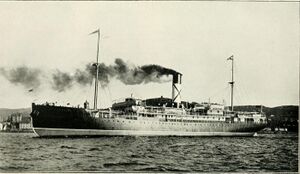Engineering:SS Stephano

| |
| History | |
|---|---|
| Name: | Stephano |
| Owner: | Bowring Brothers |
| Builder: | Charles Cornell & Co. Ltd. Scotstoun |
| Yard number: | 341 |
| Launched: | 2 May 1911 Glasgow, Scotland |
| Completed: | June 1911 |
| In service: | 1911 |
| Out of service: | 8 October 1916 |
| Identification: | Official Number 131350 |
| Fate: | Torpedoed and sunk near Nantucket, United States |
| General characteristics | |
| Length: | 326.1 ft (99.4 m)[1] |
| Beam: | 46.3 ft (14.1 m) |
| Depth: | 19.9 ft (6.1 m) |
| Installed power: | 1 × 3 cyl. triple expansion steam engine, single shaft. output: 577 nhp[2] |
| Propulsion: | 1 screw |
| Speed: | 13 knots (24 km/h; 15 mph) |
| Capacity: |
|
SS Stephano was a passenger liner and sealing ship, owned by Bowring Brothers and operated in their Red Cross Line of Arctic steamships. Stephano is most notable for her role in the 1914 Newfoundland Sealing Disaster, under the command of Captain Abram Kean. Stephano was the sister ship to the SS Florizel.
History
Early career
Stephano served in Bowring Brothers' Red Cross Line as a passenger steamer, and cargo vessel, between New York City and St. John's, Newfoundland, from 1911 until her sinking in 1916.[3]
1914 Newfoundland Sealing Disaster
During the 1914 sealing season, Stephano was under the command of Captain Abram Kean, a renowned sealing captain with a reputation of bringing home record breaking hauls of seal. Capt. Kean's son, Westbury Kean, was the captain of the SS Newfoundland at the time, and the two agreed to alert each other of the locations of packs of seal, despite working for separate companies.
After becoming stuck in the ice, Westbury Kean ordered his crew onto the ice to travel to the Stephano. Upon reaching the Stephano, the crew of the Newfoundland were welcomed onboard and fed lunch. Abram Kean then moved the Stephano to a pack of seals and ordered the Newfoundland crew over the side. Kean left the crew and the Stephano traveled elsewhere. The crew of the Newfoundland were left on the ice for two days and nights, during a major storm, resulting in the deaths of 77 men.[4]
First World War
On 20 March 1915, Stephano transported D Company of the First Newfoundland Regiment to Halifax, Nova Scotia, where they boarded the SS Orduña to Great Britain.[5]
Sinking
On 8 October 1916, Stephano was torpedoed by the German submarine, SM U-53, 2.5 miles (4.0 km) east-north-east of Nantucket, Massachusetts . As a result, the vessel sunk; however, there were no casualties of the 94 passengers. Stephano was one of five vessels sunk by U-53 that day.[6]
References
- ↑ "Screw Steamer STEPHANO built by Charles Connell & Company in 1911 for New York, Newfoundland & Halifax S.S. Co.LTD. - C.T.Bowring & Co. LTD., Liverpool, Passenger / Cargo". http://www.clydeships.co.uk/view.php?ref=4838.
- ↑ "SS Stephano (+1916)". wrecksite.eu. https://www.wrecksite.eu/wreck.aspx?18424.
- ↑ ""S.S. "Stephano" entering St. John's, Newfoundland, passing Cabot Tower, Signal Hill"". https://mha.mun.ca/mha/pviewphoto/Record_ID/774.
- ↑ "The 1914 Sealing Disaster". https://www.heritage.nf.ca/articles/politics/sealing-disaster-1914.php.
- ↑ "Troop Transports, Royal Newfoundland Regiment in the First World War". https://www.heritage.nf.ca/first-world-war/gallery/royal-newfoundland-regiment/ships.php.
- ↑ "Passenger steamer Stephano - Ships hit by U-boats - German and Austrian U-boats of World War One - Kaiserliche Marine". https://uboat.net/wwi/ships_hit/5773.html.
External links
 |

